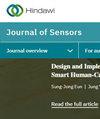A Passive Wireless Smart Washer for Locking Force Monitoring on the Orthopedic Pedicle Screw
IF 1.1
4区 工程技术
Q3 ENGINEERING, ELECTRICAL & ELECTRONIC
引用次数: 0
Abstract
A pedicle screw is a component for fixation in spine fusion surgery, often for patients with osteoporosis. Spine fusion condition highly depends on whether the pedicle screw is tightly fixed on spine, if not, spine fusion will not work properly. After the surgery, the first 3 months is the most crucial period, and bone healing situation cannot be shown through X-ray before the first radiologic images taken around the sixth week. Therefore, it is helpful to have a nonradiative method to monitor the locking force of the pedicle screw after surgery, especially during the early stage. Here a passive wireless force sensor is developed for monitoring the locking force of the pedicle screw, as we call it a smart washer. By integrating a capacitive ring-shape force sensor with an inductor, a passive LC sensor can be built by measuring the resonant frequency wirelessly. The smart washer is designed and calibrated to establish the relation between the locking force and resonant frequency, and then it is fixed with a screw in a porcine femur, with and without medium between the reader and inductor. When the locking force decreases from 8.3 to 0.9 N, the error is less than 0.5 N, and the maximum wireless sensing distance is 72 mm. However, the medium between the reader and the sensor inductor will affect the resonant frequency, but not the sensitivity. Therefore, the locking force variation can still be calculated by the resonant frequency shift accurately. Furthermore, by designing another five LC sensors with different operating resonant frequency ranges, it is possible to identify locking forces at different locations for more pedicle screws. To our knowledge, no LC force sensor was proposed to monitor the locking force of pedicle screws after surgery in the past.用于监测骨科椎弓根螺钉锁定力的无源无线智能垫圈
椎弓根螺钉是脊柱融合手术中的固定部件,通常用于骨质疏松症患者。脊柱融合的状况在很大程度上取决于椎弓根螺钉是否紧密地固定在脊柱上,否则脊柱融合将无法正常进行。术后前 3 个月是最关键的时期,在第 6 周左右拍摄第一张 X 光片之前,骨愈合情况无法通过 X 光片显示出来。因此,采用非辐射方法监测术后椎弓根螺钉的锁定力很有帮助,尤其是在早期阶段。在此,我们开发了一种用于监测椎弓根螺钉锁定力的无源无线力传感器,我们称之为智能垫圈。通过将电容式环形力传感器与电感器集成在一起,可以通过无线测量谐振频率建立一个无源 LC 传感器。我们设计并校准了智能垫圈,以确定锁定力与共振频率之间的关系,然后用螺钉将其固定在猪股骨上,读取器与电感器之间有无介质。当锁定力从 8.3 N 减小到 0.9 N 时,误差小于 0.5 N,最大无线感应距离为 72 mm。然而,读取器和感应器之间的介质会影响谐振频率,但不会影响灵敏度。因此,仍然可以通过谐振频率偏移准确计算出锁定力的变化。此外,通过设计另外五个具有不同工作谐振频率范围的 LC 传感器,可以识别更多椎弓根螺钉在不同位置的锁定力。据我们所知,过去没有人提出用 LC 力传感器来监测椎弓根螺钉术后的锁定力。
本文章由计算机程序翻译,如有差异,请以英文原文为准。
求助全文
约1分钟内获得全文
求助全文
来源期刊

Journal of Sensors
ENGINEERING, ELECTRICAL & ELECTRONIC-INSTRUMENTS & INSTRUMENTATION
CiteScore
4.10
自引率
5.30%
发文量
833
审稿时长
18 weeks
期刊介绍:
Journal of Sensors publishes papers related to all aspects of sensors, from their theory and design, to the applications of complete sensing devices. All classes of sensor are covered, including acoustic, biological, chemical, electronic, electromagnetic (including optical), mechanical, proximity, and thermal. Submissions relating to wearable, implantable, and remote sensing devices are encouraged.
Envisaged applications include, but are not limited to:
-Medical, healthcare, and lifestyle monitoring
-Environmental and atmospheric monitoring
-Sensing for engineering, manufacturing and processing industries
-Transportation, navigation, and geolocation
-Vision, perception, and sensing for robots and UAVs
The journal welcomes articles that, as well as the sensor technology itself, consider the practical aspects of modern sensor implementation, such as networking, communications, signal processing, and data management.
As well as original research, the Journal of Sensors also publishes focused review articles that examine the state of the art, identify emerging trends, and suggest future directions for developing fields.
 求助内容:
求助内容: 应助结果提醒方式:
应助结果提醒方式:


